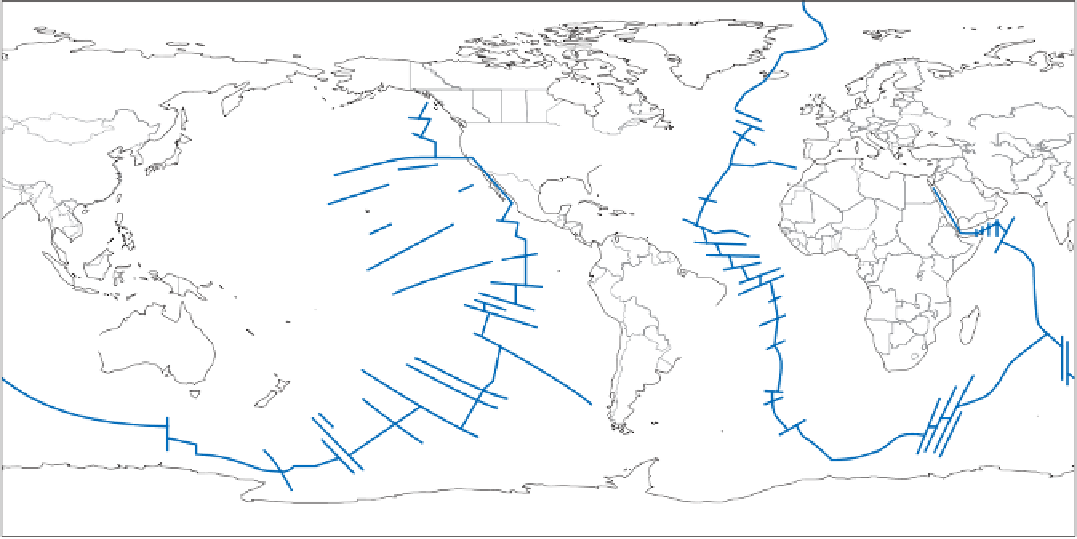Geology Reference
In-Depth Information
Eurasian
Plate
Eurasian
Plate
North
American
Plate
Caribbean
Plate
Aleutian Arc
Japan
Juan
de Fuca
Plate
Arabian
Plate
Red Sea
Philippine
Plate
African
Plate
Pacific
Plate
Gulf of
Aden
Cocos
Plate
East
African
Rift
South
American
Plate
Nazca
Plate
Indian-Australian
Plate
Antarctic Plate
Antarctic Plate
◗
Figure 23.3
Present-Day Orogenic Activity Most of Earth's geologically recent and present-day
orogenic activity is concentrated in the circum-Pacifi c and Alpine-Himalayan orogenic belts.
India's collision probably began about 40 to 50 million
years ago when the northward movement of the Indian
plate decreased from 15 to 20 cm/yr to about 5 cm/yr. This
decrease probably marks the time of collision and India's
resistance to subduction, but the Indian plate has been
thrust about 2000 km beneath Asia, causing crustal thick-
ening. This underthrusting continues at about 5 cm/yr (see
Figure 10.22).
is the
North American Cordillera
, which we discuss in the
next section.
PALEOGENE AND NEOGENE
We noted in the Introduction that many of Earth's features
have long histories, but that they owe their present distinc-
tive aspects to events that occurred during the Cenozoic Era,
that is, during the Paleogene and Neogene periods.
The
circum-Pacific orogenic belt
is an area of tectonism
made up of several orogens along the western margins of
South, Central, and North America, as well as the Aleutian
Islands, the eastern margin of Asia, and the islands north
of Australia and New Zealand (Figure 23.3). Subduction
of oceanic lithosphere causes deformation and volcanism
in the orogens in the western and northern Pacifi c. For ex-
ample, the Pacifi c plate is subducted beneath the Aleutian
Islands, Japan, and the Philippines, accounting for continu-
ing tectonism in these areas.
In the eastern part of the Pacific, the Cocos and
Nazca plates moved west from the East Pacifi c Rise only
to be consumed at subduction zones along the west coasts
of Central and South America, respectively (see Figure
10.21). This entire region also remains tectonically ac-
tive. In South America, for instance, the Andes Mountains,
with about 50 peaks higher than 6000 m, also has many
active volcanoes and it is an area of seismic activity. An-
other important part of the circum-Pacifi c orogenic belt
The
North American Cordillera
, a complex mountainous
region in the West, is a huge segment of the circum-Pacifi c
orogenic belt extending from Alaska southward through
Canada and the continental United States and into central
Mexico. In the United States, it widens to 1200 km, stretch-
ing east-west from the east flank of the Rocky Mountains
to the Pacifi c Ocean (
Figure 23.4). Although the geologic
evolution of this region began during the Proterozoic, a
protracted episode of deformation known as the
Cordille-
ran orogeny
began during the Late Triassic as the Nevadan,
Sevier, and Laramide orogenies progressively affected areas
from west to east (see Figure 22.11). The fi rst two of these
orogenies were discussed in Chapter 22, so here we are con-
cerned with the Laramide orogeny.
The Late Cretaceous to Eocene
Laramide orogeny
was
the last event in the Cordilleran orogeny, but it differed from
its two predecessors in important ways. First, it took place
◗



Search WWH ::

Custom Search